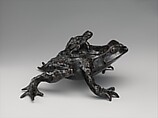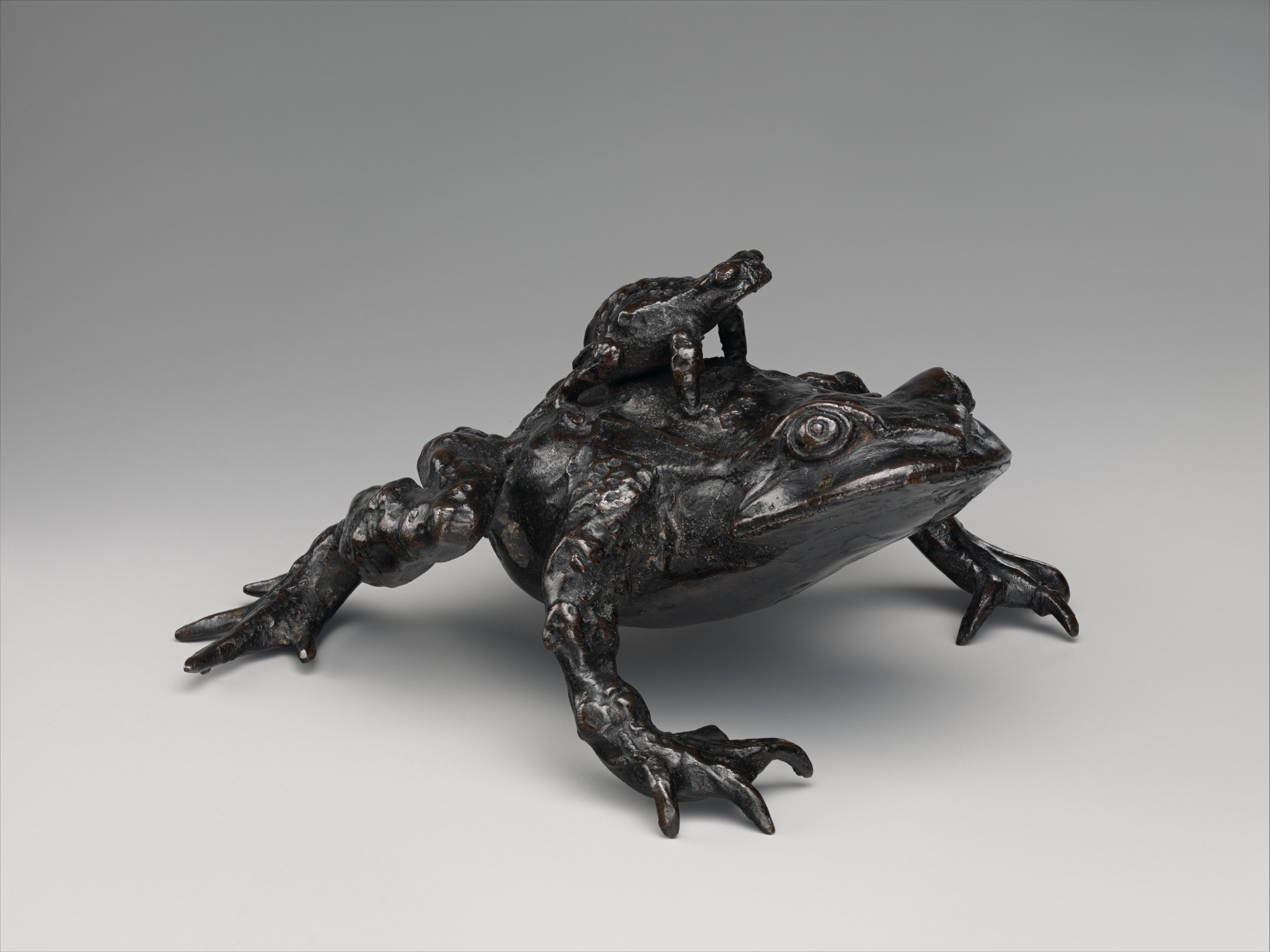Toad with a Young Toad on its Back
Not on view
In Italy, around 1500, the revival of small-scale bronze production dovetailed with a renewed interest in natural history, demonstrated by the large number of lifecasts of crabs, frogs, toads, snakes, salamanders, and other assorted flora and fauna. Nowhere was this truer than in the humanist center of Padua, where casts after zoological and botanical specimens reflected simultaneous scientific investigations into natural phenomena. These casts, not only in bronze but also lead, tin, silver, and gold, may have served practical functions, as paperweights or inkwells in a scholar’s study; as taxonomical aids; or as components of larger sculptural ensembles. Since the publication of Leo Planiscig’s influential monograph on Riccio in 1927, many of these small bronze casts have been assigned to him and his workshop, though there is little evidence to substantiate the connection.[1] Wherever its origins, the practice of lifecasting spread north to the Vischer and Jamnitzer workshops in Nuremberg, and Bernard Palissy’s atelier in France.
An ancient practice, lifecasting is first mentioned in the Renaissance by Cennino Cennini in his Il libro dell’arte, likely written in Padua around 1400. Though Cennini devotes the lion’s share of his attention to casting human faces and bodies, he also notes, “You may similarly cast any member separately, an arm, a hand, a foot, a leg, a bird, a beast, or any kind of animal or fish. But the animals must be dead, because they have neither the sense nor firmness to stand still.”[2] The techniques and processes of early modern lifecasting have only recently begun to be reconstructed based on surviving instructional manuscripts and other technical evidence.[3]
Generally speaking, an animal would have to be recently deceased, perhaps stunned with ammonia or urine, so that it could be pliably molded into the desired form but still hardy enough to withstand the process. After a mold was formed around the animal, its body was burned out and its calcined remains cleared. Then a wax model was formed from this negative impression. Absent evidence of organic materials, it is difficult to pronounce with certainty that an object was cast from life, though the chances are more likely the sharper and more detailed the features. The presence of mold lines, small seams along the bronze’s midsection, may also indicate the work was lifecast with a two-piece mold.[4]
Bronze frogs or toads with gaping maws were used as inkwells. Our two examples, mouths firmly clamped shut, probably served as paperweights. The toad with a smaller toad on its back displays a certain rubberiness and imprecision in its details that suggest much freehand sculpting in the wax, even if it was originally modeled after a dead animal. The walls are of inconsistent thickness; in some spots, like the underside, the intact core is visible. The pairing of a toad and its offspring adds an affective charge to the object, manifesting themes of familial bonds, of parent and child, and of the nature of regeneration and reproduction.[5]
In the Renaissance imagination, frogs and toads were thought to undergo a cycle of congelation and putrefaction, of solidifying into form each spring and fusing back into the mud each autumn. For example, the French naturalist Pierre Belon declared, “that which I find most admirable about the frog is that at the end of about six months it turns back into silt. And when spring arrives, they come together again: nonetheless they also breed and make eggs and little ones.”6 Similarly, the Italian physician and mathematician Girolamo Cardano observed that “frogs are born of impure water and sometimes of rain: it is believed, however, that a certain number of imperfect animals are born, without seed, from corruption.”[7]
The creatures’ enigmatic process of generation, in which liquids turned solid under extreme conditions, found parallels in the alchemical process of bronze casting itself, as molten metal was miraculously transformed into solidified specimens. Highlighting the theme of childrearing could invoke these associations. The subject of a toad carrying a smaller toad on its back is known in multiple, though far from identical, casts. But while solo bronze frogs and toads were produced widely, the parent-progeny conceit was notable enough for the dealer C. G. Copper to remark on its rarity when he sold a version now in the Fitzwilliam.[8]
Bronzes were frequently painted or otherwise patterned to simulate the effects of a naturalistic coloring, the purpose of the brown patination seen on our single toad. The stippling pattern was likely produced in the wax. The sharper features suggest the toad was cast from an actual specimen and manipulated subsequently to produce a desired effect. While both bronze toads in The Met’s collection can be generically linked to Riccio and the Paduan ambient of the early sixteenth century, there is little to date them with any precision to such an early period.
-JF
Footnotes
(For key to shortened references see bibliography in Allen, Italian Renaissance and Baroque Bronzes in The Metropolitan Museum of Art. NY: The Metropolitan Museum of Art, 2022.)
1. Planiscig 1927, figs. 450–64.
2. Cennini 1899, p. 175.
3. See the important analysis of a late sixteenth-century French technical manuscript in P. Smith and Beentjes 2010. See also Lein 2006 and Bennekom 2018. For general discussions of casting after nature, see Leeds 2005, pp. 20–35 (Frits Scholten) and 64–65 (Martina Droth).
4. P. Smith and Beentjes 2010, pp. 143–60.
5. Beck and Bol 1985, cat. 281.
6. Belon 1555, pp. 48–49.
7. Cardano 1556, n.p.
8. Fitzwilliam, M.30-1997; see V. Avery and Dillon 2002, p. 317, cat. 53, p. 210 n. 2. See also the cast in the National Gallery of Art, Washington, D.C., 1957.14.88; Pope-Hennessy 1965, no. 509, fig. 513.
Due to rights restrictions, this image cannot be enlarged, viewed at full screen, or downloaded.
This artwork is meant to be viewed from right to left. Scroll left to view more.




